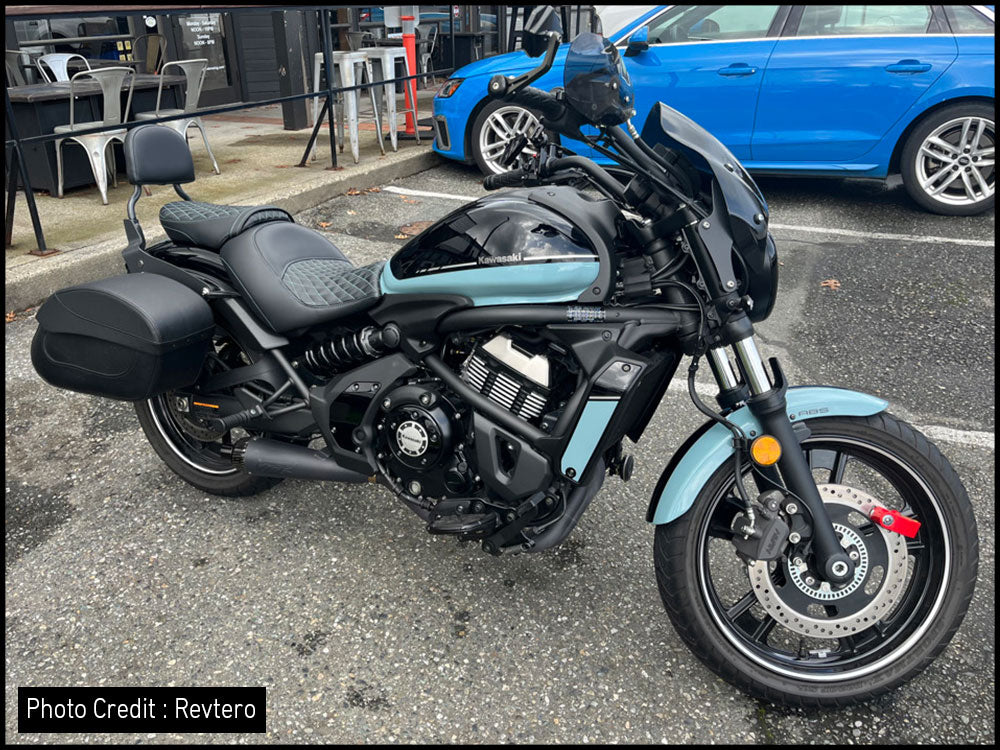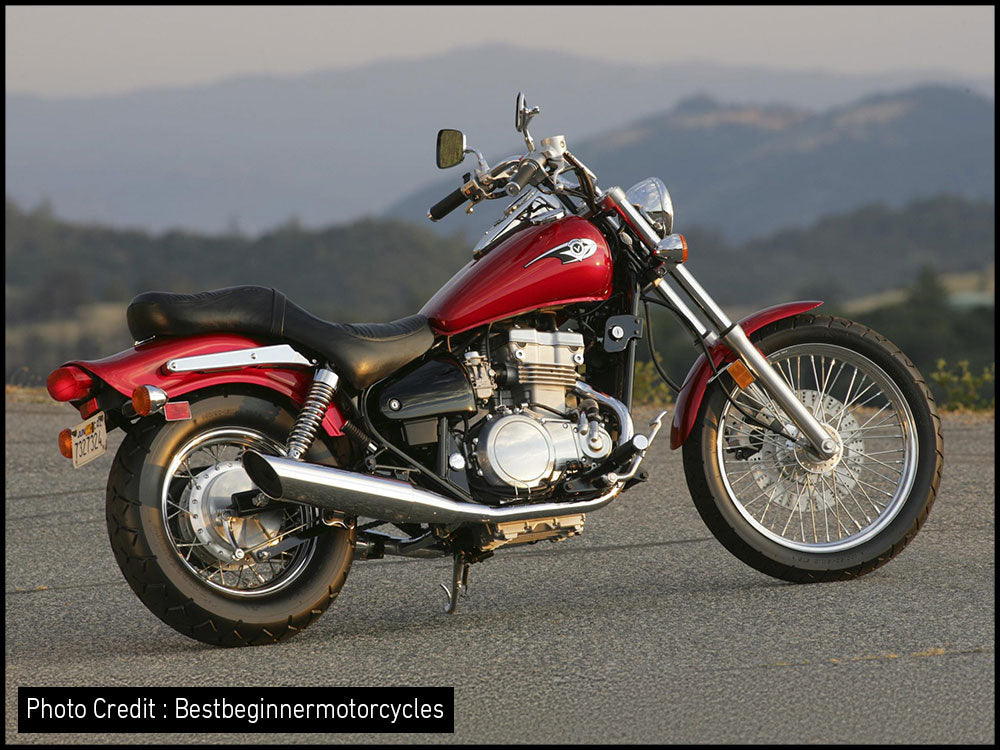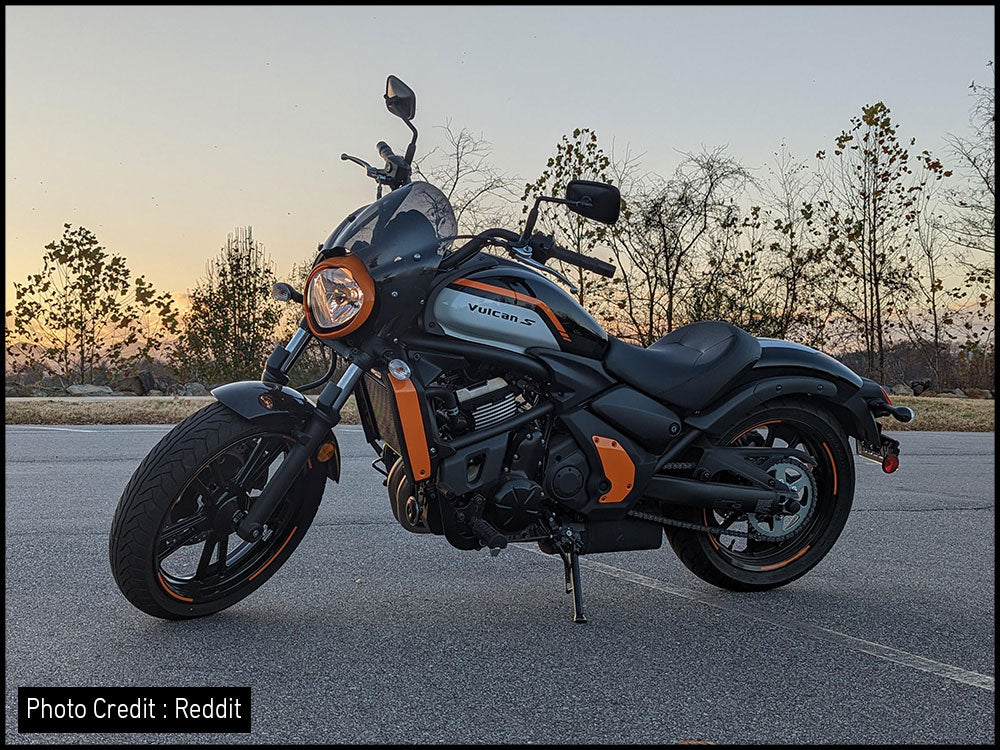As a beginner, are you thinking about buying a new motorcycle? It's difficult to choose from a number of brands and models. But any experience you’ve had with a particular brand can have a great effect on your preferences. This includes private experiences, impressions from any interactions you might have had with certain brands, and comments that you’ve heard from other riders.
Our aim is to tell riders everything about the motorcycles they love and help them to decide. After discussing the types of Suzuki motorcycles, now we are showcasing the bike profiles for Kawasaki as well. So, let's get started with the Kawasaki Vulcan S ABS Cafe, the lightest motorcycle in the Kawasaki cruiser lineup.
Kawasaki launched the Vulcan S for riders who adore versatility. The bike appeals to a variety of riders with its adjustable handlebar position, seat height, and footpegs. The Vulcan S has a powerful Ninja-derived engine, handles with ease, and customizable Kawasaki Ergo-Fit components. Though, the bike has the low and lean profile of the bigger cruisers.
Read on to find out everything you want to know about Kawasaki Vulcan S ABS Cafe, including detailed specs, background, performance, and more.
Table of Content
1. A Brief History of Kawasaki Vulcan S ABS Café
The Vulcan series made its debut when Kawasaki introduced the VN750 in 1985. This was the first year the company introduced its first cruiser. Vulcans represented the cruiser lineup of motorcycles built by Kawasaki. The models from this lineup mostly used V-twin engines, ranging from as small as 500cc to as large as 2053cc.
After a short time, the U.S. imposed tariff restrictions on motorcycles with more than 700cc displacements. Kawasaki downsized the original 750cc Vulcan to 699cc until the import restrictions ended in 1986. The Kawasaki Vulcan 750 came with a liquid-cooled, DOHC, V-twin engine that outputs 60 horsepower. The engine was combined with a five-speed gearbox and shaft drive. The 750 Vulcan remained in production for 23 years until it was discontinued by the company after 2006.
In 1990, the company launched a Vulcan model with a smaller displacement, the VN500. The Vulcan 500 was an entry-level model that came with an air-cooled 498cc parallel-Twin engine. This model remained in Kawasaki’s model line-up until it was discontinued in 2010.
Kawasaki also introduced two more Vulcan models in the 1990s, the Vulcan 800 and the Vulcan 1500. The 1991 Vulcan 1500 was the first heavyweight cruiser from the company and came with a liquid-cooled, SOHC, 1470cc, 50-degree V-twin engine, producing 84.6 lb-ft of torque at 2800 rpm.
The Vulcan 1500 stayed in production until 2008.
With the passing years, Kawasaki produced back-to-back hits on the market, but 2015 was the year that gave birth to the Vulcan 650 S series. The Vulcan 650 S is the designation of a Sports cruiser and was introduced with an Ergo-Fit system designed for enhanced custom comfort adjustability for riders of different sizes.
Upon being available to the public, the bike was available with a choice of three footpeg positions, three-seat, and two handlebars. The engine is a 649cc parallel-twin evolved from the Ninja 650, with redesigned intake and heavier flywheels that allow the Vulcan S more low and mid-range torque. The bike has a novel frame and unique suspension layout, helping it differ from other traditional cruisers.
2. Kawasaki Vulcan S ABS Cafe At First Glance

The Vulcan S ABS Cafe is powered by a 649cc four-stroke, two-cylinder, DOHC, liquid-cooled engine that evolved from the sporty Ninja 650. This engine is specially designed for more aggressive power delivery, with increased bottom-end torque at all engine rpms. All these alterations allow for a relaxing ride when you are navigating the highway. Even the most cautious rider will occasionally feel the desire for speed or power to get around a traffic jam.
The Vulcan S engine outputs a 46.3 lb/ft of torque at 6600 rpm, which is plenty of power for its 500-lb curb weight. The torque travels through the cruiser-tuned intakes in the 38 mm throttle bodies, dual-valve induction management, and cam grinds, as well as the massive mass of the flywheel. A balancer shaft is used to counter balance any uneven shifts in weight and reduce vibrations from the engine.
Kawasaki has used its own Digital Fuel Injection System to help with the transfer of low-end torque. It is clear that the company wanted to make sure the sporty Ninja engine sounded grunty enough to fulfill its new function.
The Vulcan S ABS Cafe is equipped with a perimeter-type frame with two fore-and-aft pipes protecting the jugs and a double-cradle supporting the engine. This tubular-steel frame supports a thin subframe sans seat rails, which keeps the rear end as slim as the rest of the bike, a bonus design feature that makes it easy for shorter riders to reach the ground.
The steering head is mounted to a 31-degree rake, the rake giving the bike an authentic cruiser look and feel, with 4.7 inches of wheel travel that improve handling when riding at highway speeds and maintaining maneuverability when turning. The vintage, right-side-up forks help provide the front end with 5.1 inches of travel. The coil-over monoshock suspension system is concealed under the rider’s right leg, giving the rear end at least 3.15 inches of wheel travel. The rear shock also features a seven-position, spring-preload adjustment so you can modify the suspension to suit your weight and reduce discomfort.
The bike has a two-pot caliper attached to the 300 mm front brake rotor and a single-pot caliper attached to the 250 mm disc towards the rear. The Vulcan S Cafe came with an ABS as part of its standard equipment.
The Kawasaki Vulcan S Cafe is convenient for riders with a broad range of body types because its Ergo-Fit concept allows the rider to adjust the size and shape of the riding triangle. A rider can add the short-reach handlebars to keep his/her hands closer to the body, reduce or extend reach using a saddle with gel inserts, and move the footpegs forward or back one inch to adjust his/her foot position.
The Vulcan S Cafe combines cruiser styling and sportbike performance. The bike has a 3.7-gallon teardrop fuel tank, a unique front inverted triangular headlight, LED taillight, and blacked-out mirrors to accompany the blacked-out muffler and frame.
3. Kawasaki Vulcan S ABS Cafe: A Buyer’s Guide
3.1. What is the Top Speed Of A Kawasaki Vulcan S Cafe?
The Vulcan S ABS Cafe is powered by a 649cc four-stroke, two-cylinder, DOHC, liquid-cooled engine, specially designed for more aggressive power delivery with increased bottom-end torque at all engine rpms. It is estimated that the Kawasaki Vulcan S ABS Cafe can reach a top speed of 116.8 mph.
3.2. Is Kawasaki Vulcan S ABS Cafe A Good Motorcycle For Touring?
The Kawasaki Vulcan S is an excellent bike with a decent engine displacement of 649ccs that is capable of producing amazing power and torque. Its low seating position and easy stance make it extremely comfortable to ride on long tours.
3.3. What Is The Cost Of Kawasaki Vulcan S?
The Vulcan S is the lightest bike in the Kawasaki Cruiser line-up. The estimated price range tends to be between $7,499 to $7,849. However, the price may change depending on your choice of ABS or NON-ABS.
4. Kawasaki Vulcan S ABS Cafe Specifications
4.1. Power
| Engine | Four-stroke, two-cylinder, DOHC, liquid-cooled |
| Displacement | 649cc |
| Bore x Stroke | 83.0 x 60.0mm |
| Compression Ratio | 10.8:1 |
| Fuel System | DFI 38mm Throttle bodies (2), and with sub-throttle valves |
| Ignition | TCBI w/ Electronic Advance |
| Transmission | Six-speed with positive neutral finder |
| Final Drive | Sealed Chain |
| Maximum Torque | 46.3 lb/ft @ 6600 rpm |
4.2. Performance
| Front Suspension / Wheel Travel | 41mm telescopic fork/5.1 in |
| Rear Suspension / Wheel Travel | Lay-down offset rear shock with linkage and adjustable preload/3.2 in |
| Front Tire | 120/70x18 |
| Rear Tire | 160/60x17 |
| Front Brakes | Single 300mm disc with twin-piston caliper |
| Rear Brakes | Single 250mm disc with single-piston caliper |
4.3. Details
| Frame Type | High-tensile steel diamond frame |
| Rake/Trail | 31/4.7 in |
| Overall Length | 90.9 in |
| Overall Width | 34.6 in |
| Overall Height | 44.5 in |
| Ground Clearance | 5.1 in |
| Seat Height | 27.8 in |
| Curb Weight | 496.1 lb* |
| Fuel Capacity | 3.7 gal |
| Wheelbase | 62.0 in |
| Color Choices | Ebony/Pearl Robotic White/Candy Steel Furnace Orange |
| Warranty | 12 Month Limited Warranty |
| Kawasaki Protection Plus™ (optional) | 12,24,36 or 48 months |
5. Aftermarket Parts And Luggage Options For Kawasaki Vulcan S ABS Cafe
Kawasaki designed the Vulcan S to be accessible to a wide range of body types and riders. The Ergo-Fit concept allows the owner to change the size and shape of the rider triangle, making the bike suited to his/her riding style. Many riders adore the modern features of the bike and want to improve the design by adding aftermarket parts like handlebars, crash bars, fairings, luggage racks, rider passenger backrests, etc.
As mentioned above, the bike is amazing for going on long tours. If you are planning to depart for adventure touring, do not forget to stuff your luggage bags with necessary items and attach a sissy bar to provide back support. Also, never compromise on the condition of your seat ; replace your old one with a new, more comfortable seat if necessary. Remember, you always have the option of attaching a solo seat or a passenger seat so you can travel with your friends and loved ones.
After returning from your camping trips or long tours, replace your luggage add-ons with a pair of premium quality saddlebags. Your bike will be ready for daily use around the city, carrying your essentials like your raincoat, mobile, and folder.













Leave a comment
All comments are moderated before being published.
This site is protected by hCaptcha and the hCaptcha Privacy Policy and Terms of Service apply.